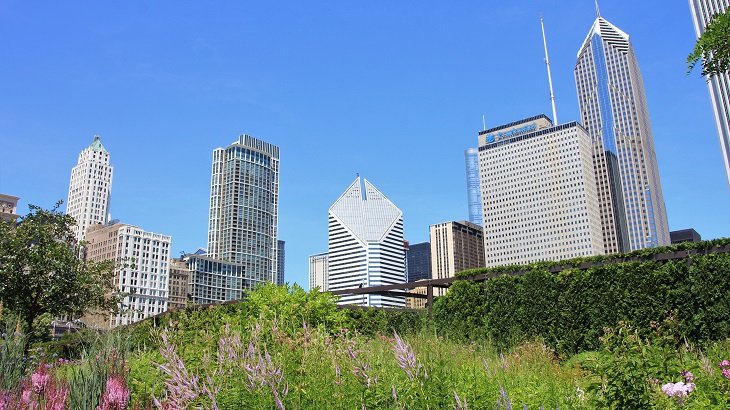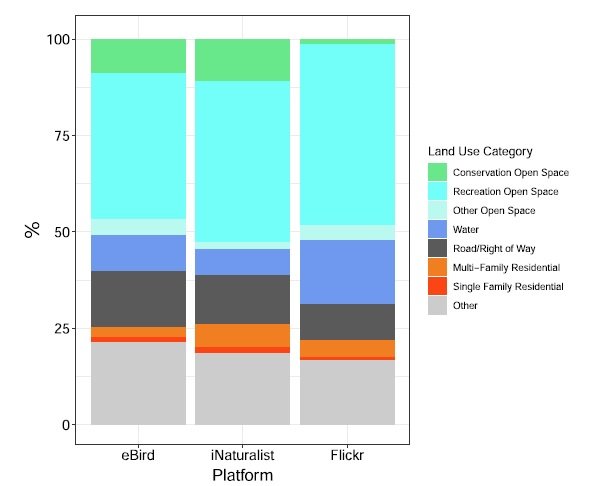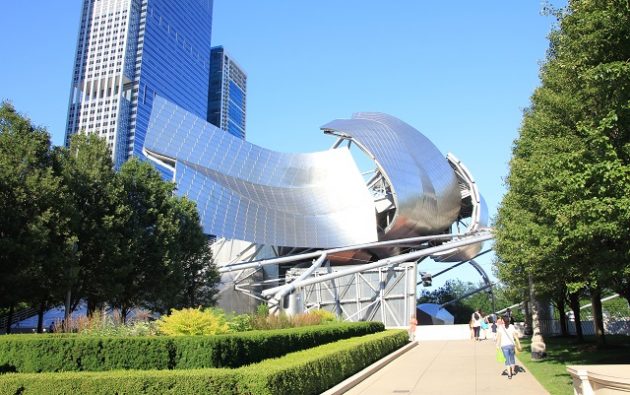
Birders who submit their checklists to eBird likely know that their data may be used to conduct research on avian migration, range, or population. But eBird data is not just for ecologists and ornithologists. It has also been used by researchers from other fields, such as economists.
Recently, an interdisciplinary group published a paper using eBird data in the journal Landscape and Urban Planning. The authors are Bianca Lopez (The New School), Emily Minor (University of Illinois at Chicago), and Andrew Crooks (George Mason University), and the article is “Insights into human-wildlife interactions in cities from bird sightings recorded online.”
As background, there is growing evidence that interactions with nature can improve the well-being of city residents. Access to urban green space is believed to be beneficial because of it reduces air pollution and provides opportunities for exercise and recreation. Green spaces may also help reduce stress.
Although there are lots of green spaces and many opportunities to observe nature in cities, there is little research on where people actually do so. To address this gap, the researchers analyzed eBird (and iNaturalist and Flickr) data in Chicago to determine where Chicagoans observe birds.
In addition to being one of the largest cities in America, Chicago sits in the transition zone between the eastern deciduous forests and prairies of the Midwest. Its eastern border is Lake Michigan, one of the largest freshwater lakes in the world. The Windy City also has an extensive waterfront, including an 18-mile lakefront trail. There are many parks, including Millennium Park, which features the famous Bean sculpture. (The photos are from Millennium Park.)
Chicago is a good place for birds: on eBird, Cook County, Illinois has nearly 400 species and more than 275,000 checklists.
The researchers divided the city’s land area into seven categories: (1) open space for conservation (e.g., forest preserves), (2) open space for recreation, (3) other open spaces (e.g., trails/greenways and cemeteries), (4) water, (5) single family residential, (6) multifamily residential, (7) roads, and (8) all others. They also obtained socioeconomic information about neighborhoods.
Then they analyzed the data:
We found evidence that people are observing birds in a wide range of land uses and neighborhoods across Chicago. Open spaces, especially recreation areas, appear to be important locations for bird observation in Chicago…. We also observed spatial patterns in bird observations across neighborhoods, with fewer observations in low-income community areas and those with less open space, as well as those farther from Lake Michigan.
Bird observations were not proportional to land area and, perhaps surprisingly, observations in recreational open space areas were much more numerous than conservation open space areas. More than 50% of observations occurred in open space, with 39% in recreation areas and 8% in conservation areas. About 4% occurred in residential areas, 14% on roadways, and 10% on water. Put another way, bird observations in open space (about 50% of observations) were vastly disproportionate to its land area (about 10% of land area).
Observations in residential areas were the opposite, with far fewer observations than its proportion of Chicago’s land area. However, the design of the study may have underestimated residential and conservation open space observations, as the authors were more interested in places where many people observe birds, not where a few people frequently observe birds.

I emailed the Dr. Lopez and asked about this research and the use of eBird data. I thank her for the response, which, lightly edited, is below.
Q: Your paper used eBird (and other) data to assess where Chicagoans observe birds. Why are birds a good proxy for broader human-wildlife interactions? Why not squirrels or racoons or butterflies?
A: Good question! Ideally, we would have data to look at all of these kinds of animals. Before selecting birds I actually did a little exploring on iNaturalist. There are a lot of observations on there for plants, birds, and moths, and butterflies, but fewer for other types of organisms—this is probably because of a combination of interest in those groups and how easy (or difficult) it is to get a picture of one to put online.
We decided to go with birds mainly because we could find data from three different websites (eBird, iNaturalist, and Flickr, which also has more bird pictures than most other groups of animals). But birds are also a great study subject because they are everywhere (and abundant in cities), they’re around during the day and easy to see, they’re easier to tell apart than animals such as insects, and (as this blog shows so well!) many, many people are interested in them.
Q: The recreational open spaces that appear to be where many people interact with birds are not evenly distributed in Chicago, as less affluent neighborhoods have fewer open spaces. What are the potential consequences of unequal opportunities to interact with nature and how might they be addressed by urban planners?
A: There is a lot of evidence out there that shows that access to open space is important for mental health because it helps people recover from stress. (I’m currently working on a study that looks at how people are using urban parks and open space during the Covid-19 pandemic and how that might be affecting their mental health and well-being.)
Open space also gives people opportunities for recreation and exercise, so it can have physical health benefits as well. This means that communities that don’t have access to open space (predominantly low-income neighborhoods and communities of color) don’t get the same potential health benefits that open spaces can provide. I’m also really interested in the feedback between living in cities and becoming disconnected from nature—when people don’t have access to nature they tend not to care as much about nature, and then they are less inclined to seek out nature—it’s a vicious circle.
Q: What does the larger body of literature, including your paper, tell us about how city folk use (or do not use) their green spaces?
A: Our paper suggests that people are using urban green spaces to seek out bird watching but are also seeing and appreciating birds in other places or while doing other activities as well. Research in Chicago and elsewhere shows that people use urban green spaces for many different things, from bird watching to playing basketball to foraging for wild plants, and that these uses can differ between different groups of people (different ages, people from different countries, etc.).
That’s one challenge for trying to design and manage urban green spaces, to meet multiple different goals and meet the needs of different kinds of people. I hope that my work helps to show some of the nuance, but also helps point to some strategies.
Q: Birders are not necessarily representative of the larger population and the paper mentions there is no demographic information regarding eBird contributors. What are the advantages and disadvantages of using eBird data and how does it impact researchers using eBird?
A: eBird is an amazing resource for research, mainly because there are so many contributors and some of them post data regularly. Many researchers also take advantage of the fact that a huge proportion of the data on eBird is collected just as a scientist would collect it, keeping track of the time spend or distance covered for each checklist. These standardizations make it much easier to compare across different checklists.
The drawback, I suppose, is that most eBird users (probably… we don’t really know!) are dedicated birdwatchers, and for the purposes of our research question we wanted to know how people in general (not just birders) interact with birds in cities. That’s why we combined data from eBird, iNaturalist, and Flickr (which presumably are used by slightly different subsets of the general population, even though this is still a biased sample) in our study. Another source of bias that probably affects other researchers is that people tend to make more observations in their backyards and in parks known for good bird watching, so we know a lot less about birds are in other places.












Fascinating discussion of the reasons to use ebird data and the limitations for this researcher’s purposes.
Thank you for this article – great summary of the paper and the interview with Dr. Lopez adds dimension. Great links throughout for more information! My team is using iNaturalist data to assess biodiversity in Chicago how we can use information inform conservation planning — more learning to come!